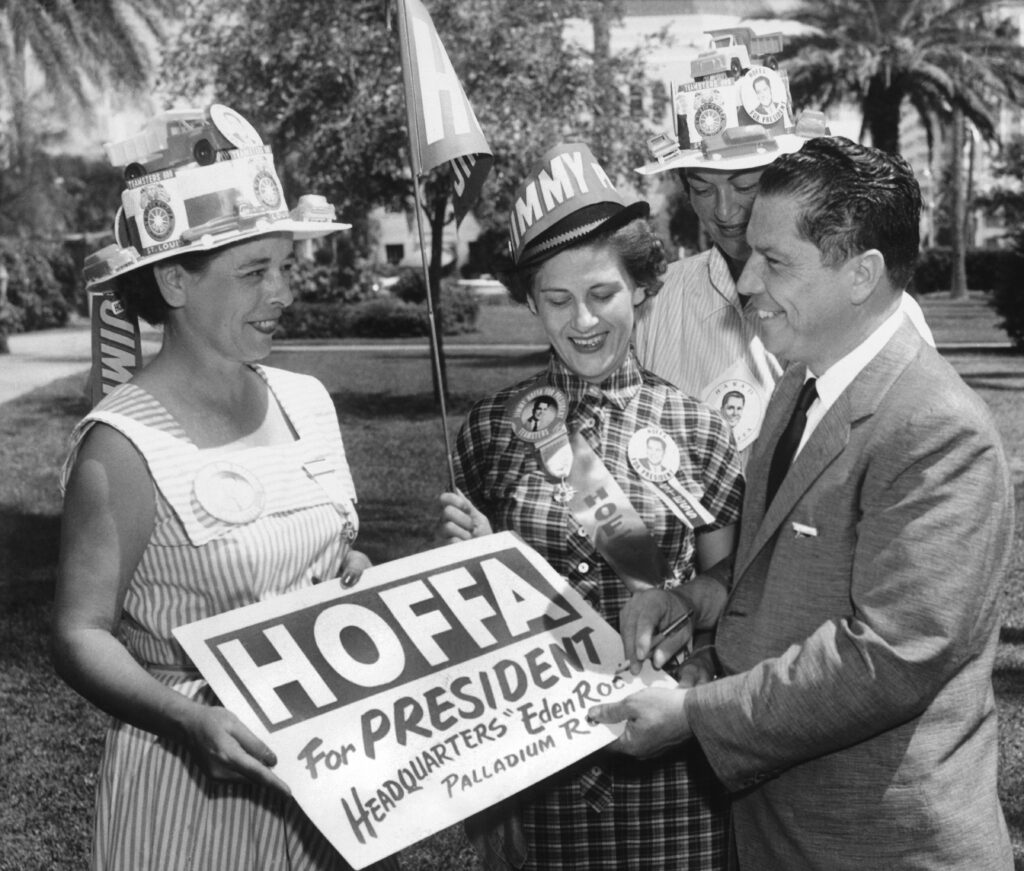
Once Hoffa got out of prison he was on a mission to regain his rightful place as Teamsters president, but a lot of people didn’t want that to happen.
Jimmy Hoffa has become a touchstone of pop culture lore due to the factors surrounding his unsolved disappearance. But to really understand who Hoffa was and the reasons for everything that occurred you have to go all the way back to the 1930s. Through the labor movement, Jimmy Hoffa was one of the most powerful and important people in the United States for a long time. President of the largest union, during the time when unions were at their peak of power.
He could sway millions of votes, shut major corporations down, and had control of the Teamsters pension fund, the largest pool of non-governmental money in the country. A fact that the Mafia exploited to build casino’s in Las Vegas, despite the fact that Hoffa was always the smartest guy in the room. He used any and everyone for whatever he could, including the mob.
It was in 1937 that his first ties with the mob came out. The Mafia’s thugs and leg breakers provided muscle for the labor movement and unions. Hoffa got them to go after stubborn employers who refused to accept the unions. As workers staged strikes to gain leverage in the workplace, gangsters and bandits took advantage of the opportunities to go semi-legitimate and grab a stake in the growing labor movement.
Hoffa learned from the depression that he had to fight for everything tooth and nail. He took this mentality to the labor movement and looked at it from a business sense. Big business and the government were not the workers friends. Corporate America would hire mob muscle to intimidate the union, but Hoffa flipped the script on them, allying with the mob for the benefit of the workers.
To the union rank and file Hoffa was a Robin Hood. And with Hoffa being able to offer the Mafia the Teamster’s trucks to smuggle contraband it was the perfect alliance. At the height of the labor movement Hoffa was the ultimate power broker, holding court with the government, big business, and the Mafia. At ease and seemingly holding all the cards. So what the hell happened?
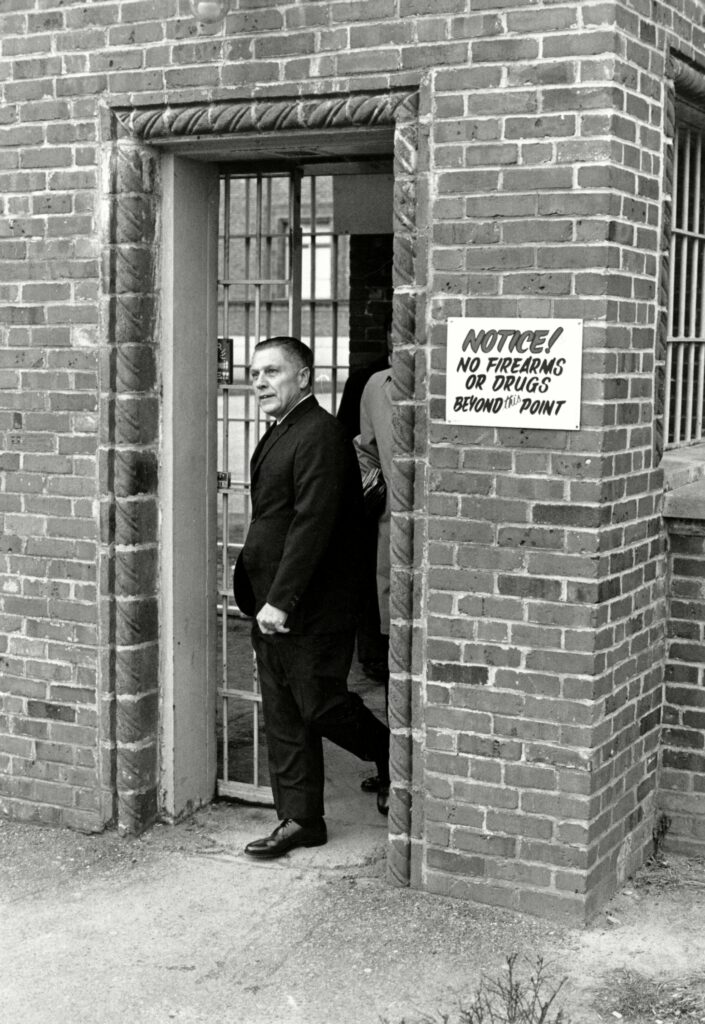
Out of Prison and Back into the World
Hoffa never viewed himself as a racketeer. He was convicted of jury tampering and fraud and sentenced to 13 years in federal prison. Buried for the near future. Out of sight and out of mind, but parole was possible in 32 months and as the former president of the Teamsters he was the highest paid prisoner in the nation.
But as he sat in prison in the late sixties and early 70s, America was changing. A lot of movements from the counterculture revolution were taking shape and aggressively influencing policy, much like Hoffa did in years prior. But Hoffa’s bread and butter, the labor movement, was getting bad reviews. After years of negative propaganda the public viewed the unions as corrupt entities that were beholden to the mob.
Hoffa spent his whole time in prison angling to get back into power with the Teamsters. It was his life and he wanted back in, despite the concentrated effort to lock him up, vilify his movement, and paint him as a dangerous man and corruptor of society. But when President Nixon pardoned him in 1971 no one was really surprised. Hoffa was a powerful man with many allies. The president of the United States seemingly among them. The Teamsters were giving money to Nixon and the Republicans, but the reason that Nixon pardoned Hoffa became a big question?
“Possibility one,” filmmaker and Detroit native Al Profit, who made the seminal documentary on Hoffa’s life- Killing Jimmy Hoffa, tells Real Crime. “Hoffa still had a lot of sway. Teamster members for the most part loved Hoffa, even when he went to prison. The Teamsters mostly voted Democrat, but if Hoffa got out and said, hey, Nixon pardoned me, vote for Nixon, he could deliver a lot of votes for Nixon. And the president knew this.”
But White House tapes from the National Archive revealed the politics behind Nixon’s Christmas Eve 1971 commutation of Hoffa’s sentence. Nixon and Attorney General John Mitchell agreed to keep Hoffa locked up until a deal was firmed up to keep him out of the Teamsters. An apparent nod to Fitzsimmons, who in return provided political and financial support for the 1971 Nixon re-election campaign.
There were rumors of seven-figure campaign contributions funneled to the incumbent’s campaign. This deal would free Hoffa, keep Fitzsimmons in power and boost the Nixon run for a second term. Nixon explained the plan in a White House chat with Mitchell: “We’re going to give Hoffa an amnesty, but we’re going to do it for a reason.”
“Possibility two and there’s a lot of evidence for this,” Profit says. “Hoffa’s buddies in the mob, Carlos Marcello- who was probably the man that orchestrated JFK’s murder- sent Nixon a bag of money, a million dollars to pardon him. There was a battle going on between Mafiasos. The New York mob didn’t want Hoffa in power, but Chicago and the Southern families, run by Marcello and Santo Trafficante, wanted him back in power with the Teamsters. There was kind of a geographic mob war and it was over Hoffa. Chiefly between New York and the Southern powers.”
The dispute rose over who was going to control the Teamster pension fund. Hoffa’s allies in the Mafia, Trafficante and Marcello, may have sent money to Nixon to pardon him so that Hoffa could get out and get back in power in the Teamsters to use his power to benefit projects that the Southern Mafia families wanted. As opposed to what the New York Mafia families wanted. Hoffa was never really a creature of New York. He was more into Detroit obviously, but also Chicago and held a special loyalty to Marcello and Trafficante.
“People don’t realize that in the 1960s the FBI considered Marcello the most powerful mobster in the country,” Profit says. “Not anybody in New York. Marcello and Trafficante had more money, more resources, and more power than anybody in New York. New York was more of a Mafia town, but in terms of individual power there wasn’t anybody in New York that could touch Marcello and Trafficante. And those were Hoffa’s two guys.”
When Hoffa got out he made a big production and formed a big prisoner rights activist thing. He’d go on talk shows and talk about how fucked up the prison system was. But behind the smoke screen he was taking meetings and scheming to get back into position with his allies Marcello and Trafficante. It was all a power play. The classic capitalistic ploy with smoke and mirrors. Orchestrated by two of the most powerful mob bosses in the country. But it wouldn’t work.
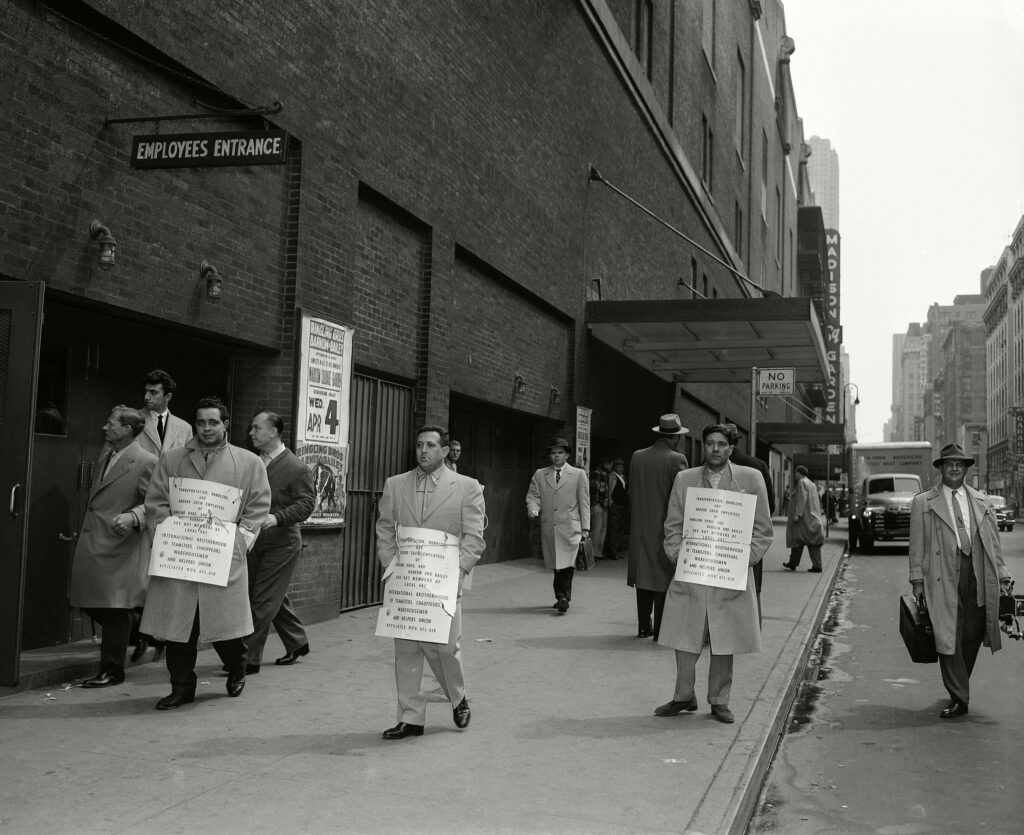
Making Waves and Causing Controversy
Despite a plea deal that banned him from participating in any union activities once out on the street, Hoffa was making plans for a comeback with the Teamsters. But the New York Mafia bosses were happy with Hoffa’s replacement, Frank Fitzsimmons, and blanched at the idea of Hoffa getting back in power. He was by now a lightning rod for law enforcement attention and the bosses were comfortable with Fitzsimmons. Hoffa’s biggest problem at the time was simple- he was stepping on the wrong toes, toes belonging to guys wearing Italian leather loafers.
“Hoffa had lunch with Fitzsimmons and when Fitzsimmons went out, his car blew up.” Profit tells Real Crime. “Was that Hoffa trying to blow up Fitzsimmons or was that somebody else trying to make it seem like Hoffa was trying to blow up Fitzsimmons? There was a lot of violence going on with the Teamsters when Hoffa got out because there was an internal power struggle going on. People were trying to blame it on Hoffa, but I don’t think Hoffa was doing it. But with everything at stake, who knows. The Teamsters pension fund had the power to loan huge amounts of money. That’s how they built the Las Vegas casinos.”
In Larry McShane’s Last Don Standing: The Secret Life of Mob Boss Ralph Natale, the Mafiaso turned snitch, told McShane that
Genovese Family boss Fat Tony Salerno assured Frank Fitzsimmons, the current president of the Teamsters, that Hoffa would never resume his prior role as president. Natale said that Hoffa even reached out to him for support. “He had some balls.” The mobster told McShane. A meet was set and the old friends shared handshakes and a hug.
Natale had once served as a Teamster official working under Hoffa. Completely comfortable with Natale, Hoffa made his pitch. But Natale claims he couldn’t give Hoffa his blessing. He had to go talk to his boss, Angelo Bruno.
And they both knew that Bruno didn’t want anything to do with Hoffa. “When he said he understood, I felt like I was at his funeral. I could smell the dirt of the grave on him,” Natale told McShane. “I hadn’t felt, to that time, so bad in my life. He was dead. He was a dead man talking to me.”
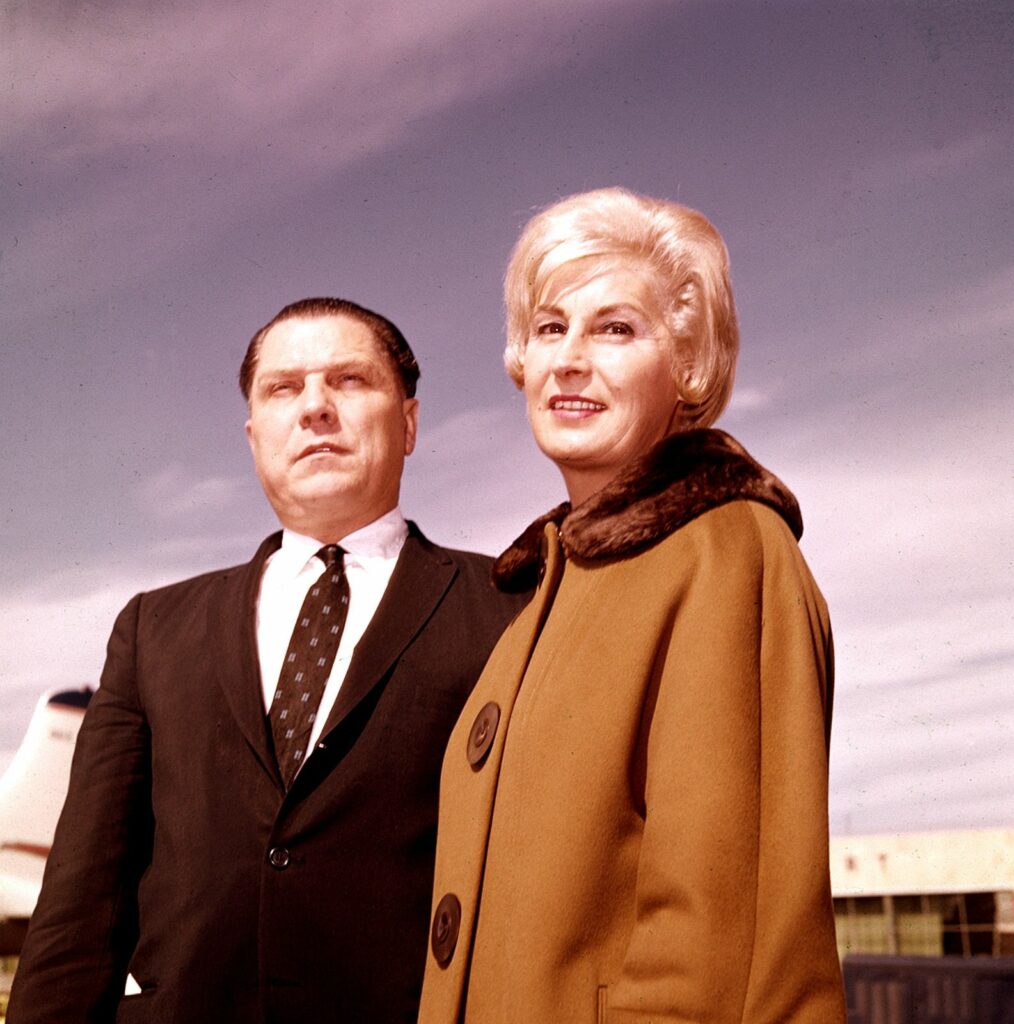
Revelations and Criminal Connections“Its easy to say he was corrupt or he was with the mob,” Profit says. “But unions in general and the Teamsters especially were infiltrated by organized crime at an early date. Being the president of the Teamsters is like being the president of the United States. You go around to different parts of the country to get the people to vote for you. When you go to Toledo, Ohio or Philadelphia or San Francisco, there’s local and powerful organized crime people that are in control, and you have to cut deals with them. Hoffa’s whole carer was jockeying between the government, big business and the most powerful organized crime figures in the country.”
When Hoffa was in charge there was a balance. Organized crime didn’t really get what they wanted, they were appeased because they had a lot of power, but they didn’t overpower anyone. There was a balance between the businesses, the government and the criminals. And the union members under Hoffa really did benefit. But when he went away, the people that took over after him, chiefly Richard Fitzsimmons, were not the same. There was no balance. They were the flunkies of organized crime and that’s why some members of organized crime didn’t want Hoffa back in power.
“Frank “Three Fingers” Coppola was an international drug dealer and one of the most powerful mobsters that you never heard of.” Profit tells Real Crime. “He bounced around the U.S. and was a made member of the Detroit family. He got deported to Sicily in 1948 right after World War 2, but he got involved in doing dirty work for the CIA. He was also the godfather of Jimmy Hoffa’s son. He was very close friends with Jimmy Hoffa. Coppola set up one of the biggest heroin rings after the war.
“Coppola was definitely a CIA asset. He was definitely protected. He was indicted in 1951, 1965, 1972, and 1983 for drug conspiracy cases, for attempted murder on Italian prosecutor, really serious charges. This guy basically never went to jail and he was one of the biggest global drug traffickers for 45 years. To this day if you do a freedom of information to the Department of Justice or the CIA they won’t release anything on him or Hoffa.”
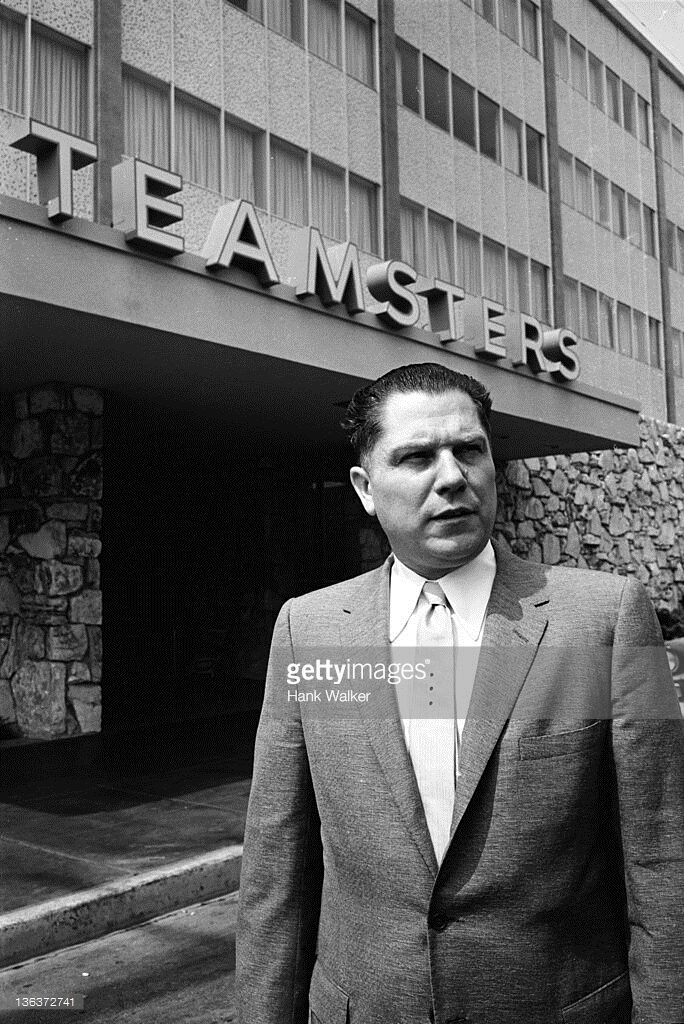
Surrounded By Enemies
“Jimmy Hoffa knew about global drug trafficking involving the CIA.” Profit says. “He knew about the JFK assassination and he knew about Castro stuff. He knew a lot of very damaging information about the highest levels of the mob, but also about the U.S. government. There was a long term concerted effort to destroy unions in America by corporate America and their flunkies. Jimmy Hoffa was America’s most effective labor leader, and they singled him out and destroyed him because they wanted to destroy the power of unions.”
Hoffa couldn’t control everything and didn’t have the power that he did in the 1950’s when he emerged from the belly of the beast in the early 1970s and tried to regain his throne. He had enemies all around. His relationship with the mob had deteriorated. Even his great benefactors, Marcello and Trafficante, were having second thoughts about him. There were rumors that Hoffa was working as an FBI informant. He was consumed with getting his position in the Teamsters back and seemed willing to go to any length to get it.
“In the time leading up to Hoffa’s death he’d been beefing with various mobsters. Anthony Giacalone was his only friend,” Profit says. “He was intimating that he was going to run and try to regain the leadership of the teamsters, but a lot of people didn’t want that to happen. Especially organized crime figures. But there was more. Bobby Kennedy and his clan saw themselves as nobility and thought they were knights in shining armor storming in to clean up all the corruption present in the evil unions. I mean they had messianic vision of themselves and Kennedy was on a mission to get Hoffa.”
Conspiracy Theories
“There was a lot going on,” Profit says. “But also, and people think of this as getting in conspiracy theory land, but its not- Hoffa knew about the attempted assassination of Fidel Castro, and other sensitive things, like drug trafficking. He knew about that whole scene and all the same names that come up in all the JFK conspiracy theories, Hoffa knew all those people. He had a lot of info in general about things that the CIA was doing or had done from the post-war all the way up into the 1970s that would have been very damaging.”
The McClellan Hearings in 1957 exposed the inner workings of the relationship between the Mafia and the Teamsters. Making it seem as if the Teamsters were just an appendage of the Mafia. Like Jimmy Hoffa was beholden to the Mafia. But that just wasn’t true. “Jimmy Hoffa skillfully played organized crime off against the bosses,” Profit says. “He played them off against the government and he got higher wages for his employees and made the Teamsters into a power.”
Hoffa was scheduled to testify at the Church Committee hearings in 1975. The committee was looking into the shady dealings of the intelligence world and how that impacted our country and foreign leaders. Some saw those hearings and Hoffa’s testimony as a possible opportunity for him to get back into power. He was that desperate and obsessed with his former position that he was maybe willing to sell his soul for his former presidency. With allegations he was working with the FBI too, it seems Hoffa was own some deceitful-type time on multiple angles. Just a matter of time before it all caught up.

Its All Over
“I guess it’s like that scene in Casino at the end,” Profit tells Real Crime. “When they’re going to trial and all the old guys are in the backroom of the court. They’re trying to decide what to do with Andy Stone. Three of them say he’s a Marine, he’s solid, don’t worry about him and one of them says, hey, the way I see it why take a chance and they kill him. Ultimately, Hoffa wasn’t a made man and like I said earlier, not only did he know a lot of mob secrets- it’s come out to be true by the CIA’s own admission, they admitted that yes, we worked with mobsters, Johnny Roselli, Sam Giancana, Santo Trafficante to try and assassinate Fidel Castro.”
Hoffa, who was once viewed as an asset to gangland’s hierarchy was now considered a liability by organized crimes Mafia chieftains. With “Three Fingers” Coppola involved with the CIA, but also close to Hoffa, was the CIA also scared of what Hoffa could say and who he could implicate when he testified at the Church Committee hearings? Through Coppola, Hoffa knew the details of the global heroin ring his friend had set up, possibly with the agency’s complicity. Doing political dirty work and more in Italy and France for the CIA to grease their palms and make sure his shipments got in. And think if Hoffa knew it all?
“Hoffa would have known about all of this stuff too.” Profit says. “The contacts at the highest levels of the mob, the people on the commission, whether it was Marcello and Trafficante, people in New York, people in Chicago with their government contacts who were protecting them. Remember Sam Giancana and Johnny Roselli were killed right around the same time as Hoffa. These were guys who knew a hell of a lot things about all kinds of stuff. About the US government, about the CIA, possibly about the JFK assassination, about drug trafficking. They just knew too much and ultimately when you know too much it’s easier to clear the decks and those guys to just go.”
All three popped up dead right before the Church Committee Hearings. The hearings were held to look into the alleged involvement of the CIA in the assassination plots of foreign leaders, covert drug smuggling, and the protection of global heroin traffickers. Certain people didn’t want Hoffa to make those hearings.The standard reason given for his death is that he was killed because of his beef with Anthony “Tony Pro” Provenzano, a Genovese Crime Family Capo, who was also the president of one of the biggest Teamster locals in the country.
“It was a convenient narrative to make it seem like he owed the mob money or whatever the fuck people think the mob killed him for,” Profit says. “Like he wouldn’t do what the mob said, so they knocked him off. I think the Mafia are certainly the ones who killed him, but I think there are bigger powers, bigger forces at play and it involved Jimmy Hoffa’s knowledge of CIA and military activity going back to the 40s. Involving the global drug traffic, involving plots to kill foreign leaders.”
Hoffa just knew too much about too many different people and too many different things. The word came from the top echelons of power and the message was that this guy had to go. According to the filmmaker Profit everything else was just a cover story. “They could make it seem like he was killed because he was in this dispute with a mobster,” Profit says. “But he would’ve been protected from Tony Provenzano. I think he just knew too much.
“He had probably started giving info to the FBI. He was going to go testify in front of Congress and he just had to go. I think it was more about knowing about U.S. government activities and the CIA contacts with the Mafia on the highest levels. There was a joint decision made between CIA slash other government people along with high level mob people to go ahead and get rid of him. It wasn’t just the mob and it wasn’t just the Tony Provenzano beef.”


